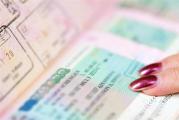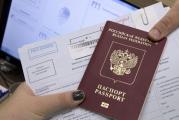How to get a Schengen multivisa
One of the pleasant events of recent days prompted me to this article: in the Spanish visa service center, Alla and I opened a six-month Schengen multivisa. That is, a multiple-entry Schengen tourist visa, or in other words, a multi-visa, which allows us to visit any country or countries of the Schengen Union without hindrance and more than once for six months. There we decided that we would go to the Czech Republic for Christmas. This country is both beautiful and tasty, and there is something to see.
For us, this is a real event. Although we have visited more than 30 countries and applied for visas on our own many times, we have always wondered how to get a Schengen multivisa. This is such a nice gift from Spain. Thanks her!
What should you check on your visa
How to make a visa on your own, we wrote and. In principle, there is nothing complicated in this. When issuing your passport, you will be asked to verify the data on the visa (dates, type of visa, dates). And here you have to be very careful.
Types of Schengen visas
First, when applying for a visa, you must understand exactly what type of visa you need. To do this, you put a tick in the right place in the questionnaire. After obtaining a passport, be sure to check that the type of visa is worth it. And you can stand there:
1. Airport Transit Visa (ATV) This visa is required for citizens of certain countries. It is designed to cross the international transit zone of airports. For example, you make a transfer at the airport of a certain country. You do not visit the country itself (do not leave the airport building), but you need an ATV visa to stay at the airport for some time.
2. Transit visa (B)- such a visa is issued for transit (passage) through the territory of the states-participants of the Schengen Agreement. The visa allows you to cross the territory of the Schengen states for one, two or more times. The time of one transit, during which you can stay in the territory of the Schengen state, should not exceed five days.
3. Tourist visa is the most common type of visa. With such a visa, you can only visit countries for the purpose of visiting attractions. A number of restrictions are imposed on this visa: you cannot be hired, undergo training, generally conduct any activity, except for rest, rest and more rest.
Such visas are given from 15 to 90 days. They are called short term. Anything over 90 days is a long-term visa.
4. National visa (D)– but just a long-term visa. If you plan to live in a Schengen country for more than 90 days in one year and are not an EU citizen, then you will need a category D visa. To obtain such a visa, you need to apply directly to the embassy.
So, open the visa in your passport and see if the type of visa you require matches or not.
If it matches, we move on.
Single Entry Schengen Visa
When examining a visa in your passport, pay attention to the item in the middle of the “Number of entries”. Usually there is either 01 or mult. Rarely, but it happens 02, 03. This means how many entries you are allowed into the Schengen countries.

01 - so with this visa you are allowed only one entry. Even if you leave the country ahead of schedule, you will no longer be able to cross the border again without obtaining a new visa. This is a single entry Schengen visa. It is usually given for the exact number of days you requested.
Accordingly, if the column contains the numbers 02, then two entries are allowed. 03 - three entries. But this rarely happens. It is easier to issue a multivisa.
Multiple entry Schengen visa
This visa only limits the total time of stay and does not prevent regular border crossings. Most often, the visa is marked mult, and allows you to travel to all Schengen countries. A multi-visa is given for a period of 90 days to 5 years. But, you can only stay in the territory of the Schengen Union countries for 90 days within six months.
For example, like our last Spanish multivisa. As you can see, the visa is valid from August 3, 2014 to January 29, 2015. But the period of stay should not exceed 90 days.

In August we are going to Spain and Portugal for 26 days. On August 29 we return to Russia. 90-26= 64. This means we still have 64 days left to use until January 29, 2015.
So, check the number of entries into the Schengen - a single or multiple entry visa you have, the start and end dates of the visa and the total duration of your stay in the country. If everything is fine, and there is no mistake, then I congratulate you, you can pack your suitcase and get ready for the trip!
How to make a Schengen multivisa
There are no rules and laws to guarantee the receipt of a multivisa. There are a number of tips and everyday experience of independent travelers.
1. Collect statistics
Explore several forums and thematic travel sites. There, people share their experience of obtaining a multivisa. If you are careful, you will definitely draw your own conclusions and prevent the likelihood of failure. After a thorough analysis and learning from someone else's positive experience, there is a high probability of obtaining a multivisa for at least six months.
2. Comply with the requirements of the embassy
For a higher probability of obtaining a multiple entry visa:
- The need for frequent visits to the country is best supported by good reasons, such as marital status abroad (children, parents, husband), studying abroad, professional activities, etc.
- Absence of fines for violations of traffic accidents and administrative violations in past visits
- Confirm your ability to pay
- Your documents must contain reliable information.
3. Many visas in the passport - good!
If you already have Schengen visas in your passport, there is a chance that you will receive a multivisa. If the passport is new and clean, be sure to attach the old passport with Schengen visas when submitting documents. The Embassy will be interested in the last 3 years. If there are visas, the chance is good!

Please note that only the consular officer will decide which visa to give you. And even if you already have 10 Schengen visas in your passport, this is not a guarantee of obtaining a multivisa. Sometimes it seems unfair when I, a hardened traveler, was not given a multi-visa, and a newcomer was given a multiple-entry visa for six months, but such is the life and will of an embassy employee!
Look for the positive side in everything. Good luck!
Sincerely,




